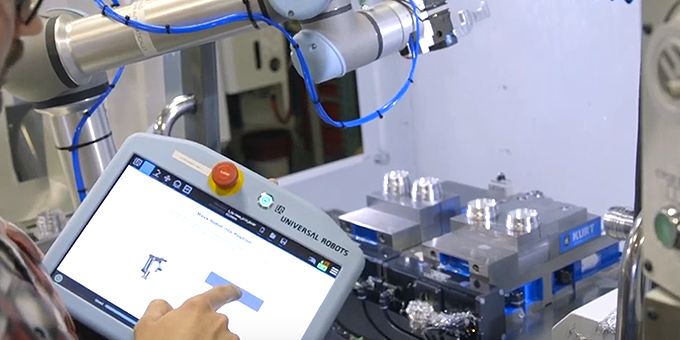Embracing the use of robotics on the production line, or incorporating AI to bring new products to market quickly, can help industrial businesses get noticed by young people and garner more interest in the employment opportunities on offer.
 The Rise of the Cobots-Friends, Not Foes, in Today's Manufacturing Landscape
The Rise of the Cobots-Friends, Not Foes, in Today's Manufacturing Landscape

Mark Hughes, Regional Vice President UK & Ireland | Epicor Software
Cobots—robots that physically interact with humans in a shared workspace—first appeared on factory floors two years ago, accounting for approximately 5 percent of global industrial robot sales in 2016. These robotic partners were hailed as ‘the future of work’, particularly in the manufacturing sector, but concerns about widespread robotic implementation are rife. Figures released by the Office for National Statistics (ONS) in March claim that 1.5 million people in England alone are at risk of losing their jobs to automation, suggesting that these fears are justified.
However, automation can actually help manufacturers thrive and survive many of the workforce challenges they currently face. These include the ‘crippling skills shortage’, which continues to blight the industry, and is putting workforces under increased pressure. At the same time, tougher immigration rules, associated with the UK’s imminent departure from the EU, means that working in the UK will become less attractive or accessible for foreign nationals. This will force manufacturers to recruit from an increasingly diminishing talent pool.
Cobots could help stem this tide—improving current employees’ job satisfaction and encouraging new talent into the sector.
Helping and attracting human workers
Recent research indicates that rather than being worried about job losses, industrial workers are in fact ready and willing to embrace robot co-workers. Indeed, 41 percent of young people said they want the opportunity to work with the latest innovations, while 33 percent of millennials want to be at the cutting edge of new developments.
Robot co-workers can also help relieve a strained workforce from manual or difficult tasks—freeing up human workers to undertake the more creative, or profit-driving, aspects of their roles. Using this new-found time, staff are able to focus on new ideas, innovations and higher-value work for the business—including business strategy, advanced analysis, and creative thinking. More time spent on these tasks will help boost revenues, enabling companies to invest further in employees so that additional business benefits can be realised.
Cobots and other new technologies will also enable manufacturers to shake off outdated perceptions and recruit new homegrown talent into the sector. Many manufacturing businesses claim that they are seen as old-fashioned (23 percent), with a further quarter (25 percent) saying they’re not viewed as being a ‘young person’s industry’.
If the sector is to become more attractive to prospective employees, these impressions need to change. Embracing the use of robotics on the production line, or incorporating AI to bring new products to market quickly, can help industrial businesses get noticed by young people and garner more interest in the employment opportunities on offer.
Office politics
To ensure people are ready and willing to embrace robot co-workers, it’s crucial that management make staff feel like they have a personal and professional stake in the changes being made. Helping employees understand the reason for a business’s investment will make it easier to overcome any potential resistance to new processes. Once they have buy-in, manufacturers then need to help their workforces digitally upskill, in order to pave the way for modernised business operations.
This additional training should be seen as a benefit, rather than burden, by workers—as it will provide new skills, and thus offer staff new opportunities to progress. Employees that want to move up the corporate ladder will need to increase their own data skills and ensure they can survive—and thrive—in a data-led workplace, given that many of us will work with algorithms in the future.
Improving productivity
Investing in robot co-workers can also help alleviate the uncertain, tumultuous times that UK manufacturers currently operate within. Cobots could help generate major benefits for UK productivity—which currently lags more than 20 percent behind the US, France, and Germany. In the UK, an astonishing 90 percent of finishing work is still done by hand. Yet research indicates that robots could shift the balance to about 20 percent, with the remainder being completed by robots under human supervision. This would unlock massive productivity benefits for manufacturers.
Many UK firms—typically in the field of automotive manufacturing—are already realising such productivity gains. For example, at the BMW MINI plant in Oxford, cobots are now used to make the riveting process more efficient. Previously, an operator had to load rivets and undertake riveting by hand. Today, however, operators simply load one side of the jig, while the robot does the riveting on the opposite side. This both speeds up the job—boosting productivity—whilst liberating workers from a low-value, repetitive task. Since a cobot can perform the same operation up to a thousand times per day, operators also no longer have to endure the kick-back from the rivet gun for up to eight hours a day.
Here, the use of cobots generates an additional advantage—cobots aren’t susceptible to contracting a repetitive strain injury (RSI), which typically occurs if people perform the same manual operation over a long period of time. It’s a human-robot collaboration that both drives down absenteeism rates and improves working conditions for the human workforce.
Sistema is another firm using robotics to boost its operations and growth. Using manufacturing equipment software (MES) has given the packaging giant real-time access to machine and quality data, which can be imported into its ERP system, allowing managers to better plan schedules and resources. In addition, access to the wealth of shop-floor data has given Sistema the ability to plan more effectively and identify efficiency opportunities that go beyond those generated by automation alone—for example, improved job scheduling, better cycling of things like colour changes (something Sistema’s packaging is renowned for), and minimising downtimes between jobs.
The future for cobots
For companies that want to produce high-quality products, provide an optimal working environment for employees and simultaneously boost output and revenue, cobot technology could be the answer.
However, to effectively embrace and integrate cobots into the workforce, appropriate preparations will be essential. Manufacturers must first ensure they have an up-to-date IT infrastructure in place to underpin this new technology. In addition, solutions such as modern enterprise resource planning (ERP) software will be crucial to coordinating robot workflows and enabling effective data sharing between machines and humans across multiple digital platforms.
The content & opinions in this article are the author’s and do not necessarily represent the views of ManufacturingTomorrow
Featured Product

